Recreation centers keep popping up all over the country. These centers are typically large and expensive to build. Creative financing is often required to get these projects off the ground and to provide the programming that stakeholders want and need.
Take, for example, the 135,000-sf Foglia Foundation Health and Recreation Center at Harper College in Palatine, Ill., which reopened last September after a $41 million renovation of that 40-year-old building, led by designer CannonDesign and construction manager Mortenson.
The community college collaborated on this project with Northwest Community Healthcare, which agreed to pay for the fitout of a new clinic that originally was going to be 5,000 sf but expanded to 10,000 sf, says Steve Paterson, Harper College’s campus architect. The college leases this space, known as the NCH Outpatient Care Center, to the hospital, and its services are available to students, employees, and the community.
The Building Team added 10,000 sf to the rec center to make way for new fitness and exercise rooms, six classrooms, and team training and competition areas, including a new dedicated wrestling room and sports medicine facilities with a hydrotherapy bath. The rec center is also headquarters for the Harper Golden Hawks athletic department and teams.
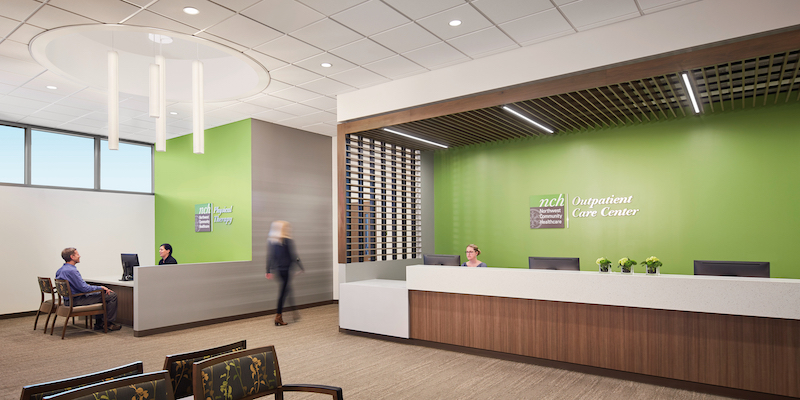
Northwest Community Healthcare agreed to finance the fitout and enlargement of a leased clinic (above) within the Foglia Foundation Health and Rec Center. And the Palatine Parks District contributed to keep the facility's pool open (below), which the district operates. Image: Dave Burk, courtesy of CannonDesign
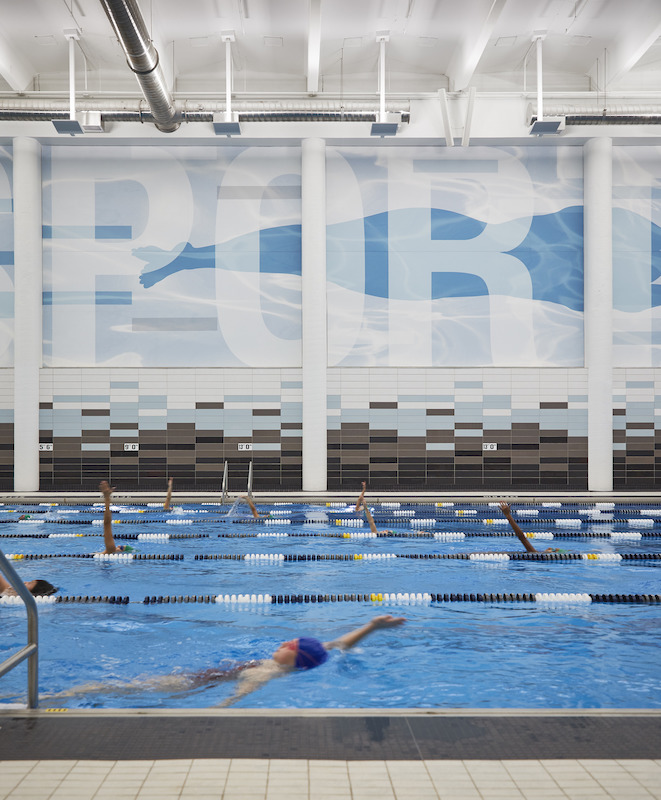
Palatine (Ill.) Park District kicked in $9 million toward the renovation to keep the facility’s pool open. The District operates the pool, says Paterson. whose programming includes aquatic, dance, sports, and fitness activities. “With one facility, we hit the trifecta,” says Mike Clark, the District’s executive director.
“I don’t know if we’ve ever done a project quite like this before,” says Roland Lemke, AIA, LEED AP, Design Principal for CannonDesign, about the way the renovation was funded. He observes that the rec center is mostly used by students during the day and by the community during nighttime hours.
CannonDesign was also involved in the new 120,000-sf Laurier YMCA Athletics and Recreation Centre in Brantford, Ont., which opened on September 14, 2018. The financing for this project came from the Y, the provincial and federal governments, corporate contributions, and Wilfrid Laurier University, whose campus is right next to the Y’s site.
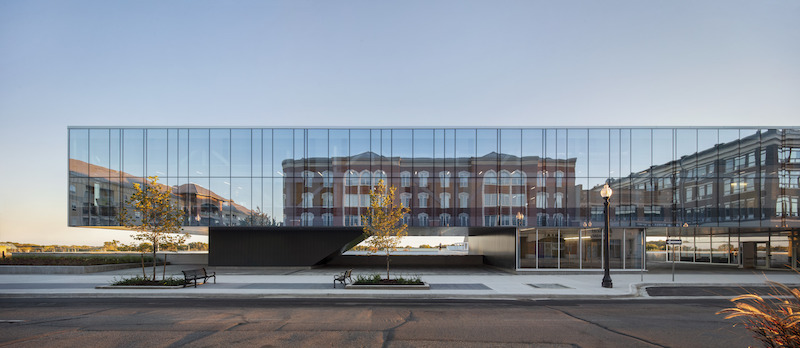
The Laurier Brantford (Ont.) YMCA and Recreational Center, whose nearly 68 million Canadian dollars in funding came from government, academic, and private sources. Image: Adrien Williams, courtesy of CannonDesign
This project had been in the works for at least eight years. Prior to the opening of the new building, the Y had been operating out of a small, temporary space, and the university had “a very small gym” for a student body that had grown to 2,500, say Antonio Araujo and Ulrike Gross, respectively the university’s Active VP-finance and administration and Acting VP-facilities and asset management.
The plans shifted into higher gear two years ago, thanks to 500,000 Canadian dollars in government grant money that paid for the building’s initial design, from which emerged “a rough concept,” says Araujo.
The project appealed to the city of Brantford as a way to help revitalize its downtown, says Genevieve Hladysh, senior regional manager for the Brantford-Hamilton-Burlington YMCA and Recreational Center. The new Y sits on a three-block site on the south side of the city, which tore down 39 mostly vacant retail buildings to clear space for construction. (Araujo and Gross note that the university initially wasn’t all that interested in this site whose main block was entirely below grade.)
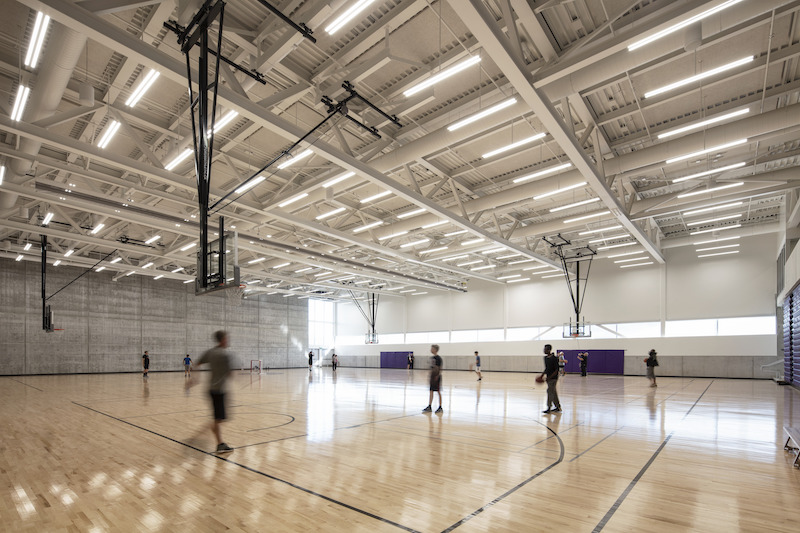
The Brantford YMCA includes a double gym. Image: Adrien Williams, courtesy of CannonDesign
The original budget for the new YMCA was 58.4 million Canadian dollars. But as more funding came on board, the budget rose to 67.7 million Canadian dollars. The federal and provincial governments each contributed C$16.7 million. The city provided $5.2 million, and another C$5.7 million was raised from a community capital campaign. The rest came from the YMCA and Laurier.
The building serves Brantford residents and university students with amenities that include an aquatics center, a double gym with retractable seating for 860 people, health consultation rooms, three studios, student lounge, and a 3,498-sf strength area.
This is the first Y to come together in an integrated space, and while the programming for each stakeholder group is spelled out contractually, “we tried to design the spaces to be as multifunctional as possible,” says Hladysh. Colleen McKenna, LEED AP, firmwide leader for CannonDesign’s sports, rec, and wellness practice, adds that while the university had a “big voice” in the programming, “there was balance and negotiation in the program distribution.”
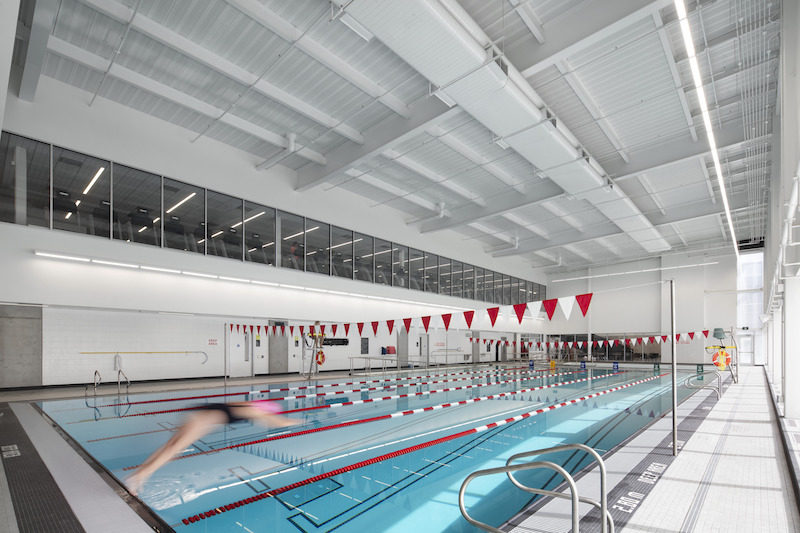
The Y's membership now exceeds 5,300, and its aquatics center is open to students and the community alike. Image: Adrien Williams, courtesy of CannonDesign
Part of the new Y’s increased cost was attributable to the construction unearthing a large archeological find: nearly 440,000 indigenous artifacts that included coins, clothing, and pottery, some of which might date back to 500 BCE. Hladysh says that the YMCA enlisted Six Nations partners to monitor the excavation. She adds that some kind of exhibit space within the new Y is under consideration.
Related Stories
| Nov 19, 2013
Top 10 green building products for 2014
Assa Abloy's power-over-ethernet access-control locks and Schüco's retrofit façade system are among the products to make BuildingGreen Inc.'s annual Top-10 Green Building Products list.
| Nov 13, 2013
Installed capacity of geothermal heat pumps to grow by 150% by 2020, says study
The worldwide installed capacity of GHP systems will reach 127.4 gigawatts-thermal over the next seven years, growth of nearly 150%, according to a recent report from Navigant Research.
| Nov 7, 2013
Fitness center design: What do higher-ed students want?
Campus fitness centers are taking their place alongside student centers, science centers, and libraries as hallmark components of a student-life experience. Here are some tips for identifying the ideal design features for your next higher-ed fitness center project.
| Oct 30, 2013
11 hot BIM/VDC topics for 2013
If you like to geek out on building information modeling and virtual design and construction, you should enjoy this overview of the top BIM/VDC topics.
| Oct 28, 2013
Urban growth doesn’t have to destroy nature—it can work with it
Our collective desire to live in cities has never been stronger. According to the World Health Organization, 60% of the world’s population will live in a city by 2030. As urban populations swell, what people demand from their cities is evolving.
| Oct 18, 2013
Researchers discover tension-fusing properties of metal
When a group of MIT researchers recently discovered that stress can cause metal alloy to fuse rather than break apart, they assumed it must be a mistake. It wasn't. The surprising finding could lead to self-healing materials that repair early damage before it has a chance to spread.
| Oct 8, 2013
Toronto Maple Leafs arena converted to university recreation facility
Using steel reinforcement and massive box trusses, a Building Team methodically inserts four new floors in the landmark arena while preserving and restoring its historic exterior.
| Oct 1, 2013
13 structural steel buildings that dazzle
The Barclays Center arena in Brooklyn and the NASCAR Hall of Fame in Charlotte, N.C., are among projects named 2013 IDEAS2 winners by the American Institute of Steel Construction.
| Sep 26, 2013
6 ways to maximize home-field advantage in sports venue design
Home-field advantage can play a significant role in game outcomes. Here are ways AEC firms can help create the conditions that draw big crowds, energize the home team to perform better, and disrupt visiting players.
| Sep 24, 2013
8 grand green roofs (and walls)
A dramatic interior green wall at Drexel University and a massive, 4.4-acre vegetated roof at the Kauffman Performing Arts Center in Kansas City are among the projects honored in the 2013 Green Roof and Wall Awards of Excellence.

















